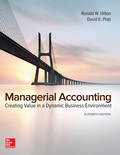
Concept explainers
MPE, Inc. will soon enter a very competitive marketplace in which it will have limited influence over the prices that are charged. Management and consultants are currently working to fine-tune the company’s sole service, which hopefully will generate a 12 percent first-year return (profit) on the firm’s $18,000,000 asset investment. Although the normal return in MPE’s industry is 14 percent, executives are willing to accept the lower figure because of various start-up inefficiencies. The following information is available for first-year operations:
Hours of service to be provided: 25,000
Anticipated variable cost per service hour: $22
Anticipated fixed cost: $1,900,000 per year
Required:
- 1. Assume that management is contemplating what price to charge in the first year of operation. The company can take its cost and add a markup to achieve a 12 percent return; alternatively, it can use target costing. Given MPE’s marketplace, which approach is probably more appropriate? Why?
- 2. How much profit must MPE generate in the first year to achieve a 12 percent return?
- 3. Calculate the revenue per hour that MPE must generate in the first year to achieve a 12 percent return.
- 4. Assume that prior to the start of business in year 1, management conducted a planning exercise to determine if MPE could attain a 14 percent return in year 2. Can the company achieve this return if (a) competitive pressures dictate a maximum selling price of $175 per hour and (b) service hours and the variable cost per service hour are the same as the amounts anticipated in year 1? Show calculations.
- 5. If your answer to requirement (4) is no, suggest and briefly describe a procedure that MPE might use to achieve the desired results.
Want to see the full answer?
Check out a sample textbook solution
Chapter 15 Solutions
Managerial Accounting: Creating Value in a Dynamic Business Environment
- help me to solve this questionsarrow_forwardNonearrow_forwardNehra Manufacturing allocates overhead at a fixed rate of $25 per hour based on direct labor hours. During the month, the total overhead incurred was $175,000, and the total direct labor hours worked was 5,000. Job number 6-60 had 700 hours of direct labor. What is the amount of overhead allocated to job 6-60? a. $20,000 b. $17,500 c. $15,000 d. $12,500 solve thisarrow_forward
- Principles of Accounting Volume 2AccountingISBN:9781947172609Author:OpenStaxPublisher:OpenStax College
 EBK CONTEMPORARY FINANCIAL MANAGEMENTFinanceISBN:9781337514835Author:MOYERPublisher:CENGAGE LEARNING - CONSIGNMENT
EBK CONTEMPORARY FINANCIAL MANAGEMENTFinanceISBN:9781337514835Author:MOYERPublisher:CENGAGE LEARNING - CONSIGNMENT Essentials of Business Analytics (MindTap Course ...StatisticsISBN:9781305627734Author:Jeffrey D. Camm, James J. Cochran, Michael J. Fry, Jeffrey W. Ohlmann, David R. AndersonPublisher:Cengage Learning
Essentials of Business Analytics (MindTap Course ...StatisticsISBN:9781305627734Author:Jeffrey D. Camm, James J. Cochran, Michael J. Fry, Jeffrey W. Ohlmann, David R. AndersonPublisher:Cengage Learning


